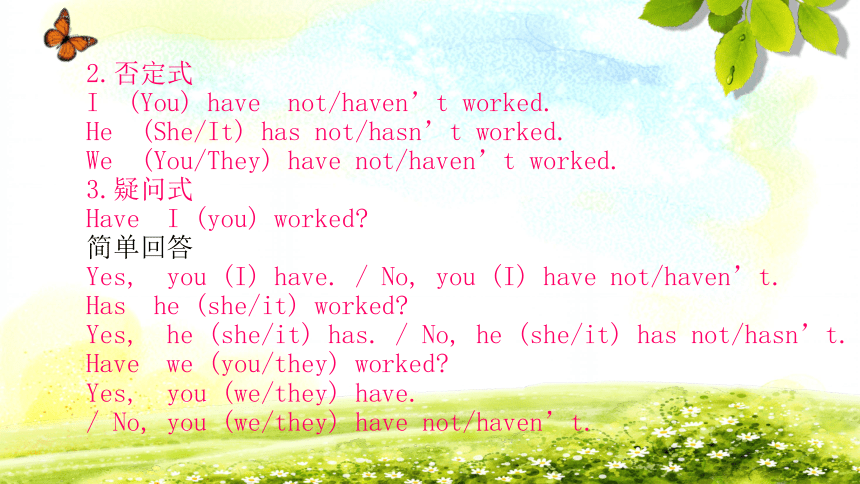仁爱版英语九年级上Unit 1 The Changing World语法复习课件(24张PPT无素材)
文档属性
| 名称 | 仁爱版英语九年级上Unit 1 The Changing World语法复习课件(24张PPT无素材) |  | |
| 格式 | zip | ||
| 文件大小 | 28.0MB | ||
| 资源类型 | 教案 | ||
| 版本资源 | 仁爱科普版 | ||
| 科目 | 英语 | ||
| 更新时间 | 2020-06-11 23:32:39 | ||
图片预览









文档简介
(共24张PPT)
九年级上册
Unit
1
语法
目录
CONTENTS
知识结构
Unit
1
语法
现在完成时
构词法
概述
用法
时间状语
动词的延续性与非延续性
现在完成时
(
The
Present
Perfect
Tense)
定义:
指过去的动作或状态持续到现在并且已经完成,
对现在造成的影响,可能持续发生下去。
在英语时态中,"时"指动作发生的时间,
"态"指动作的样子和状态。
。
现在完成时
01
现在完成时
现在完成时的构成:
助动词have/has+过去分词。
它的肯定式、否定式、疑问式和答语的结构
(以work为例)如:
1.肯定式
I
(You)have
worked.
He
(She/It)
has
worked.
We
(You/They)
have
worked.
2.否定式
I
(You)
have
not/haven’t
worked.
He
(She/It)
has
not/hasn’t
worked.
We
(You/They)
have
not/haven’t
worked.
3.疑问式
Have
I
(you)
worked?
简单回答
Yes,
you
(I)
have.
/
No,
you
(I)
have
not/haven’t.
Has
he
(she/it)
worked?
Yes,
he
(she/it)
has.
/
No,
he
(she/it)
has
not/hasn’t.
Have
we
(you/they)
worked?
Yes,
you
(we/they)
have.
/
No,
you
(we/they)
have
not/haven’t.
现在完成时态的句式:
(1)
I
have
been
to
Mount
Huang
with
my
parents.
(2)
I
haven’t
seen
him
for
a
long
time.
(3)
Where
have
you
been?
(4)
——Have
you
ever
cleaned
a
room?
——Yes,
I
have.
/
No,
I
haven’t.
02
用法
现在完成时的用法:表示过去某一时间发生的动作或存在的状态,对现在仍有影响。
I
have
just
posted
the
letter.
我刚把信邮寄了。
She
has
lost
her
watch.
她弄丢了手表。
现在完成时态的构成:
助动词have/has+动词的过去分词
You
have
just
come
back
from
your
hometown.
have/
has
been与
have/has
gone
的区别
have
(has)
been
to
+某地,
说明到过某地,说话时已回来
He
has
been
to
Beijing
three
times.
他去过北京三次。
I
have
been
to
Mount
Huang
with
my
parents.
have
(has)
gone
to
+某地,
说明去某地了,说话时还没回来。
例句:
He
has
gone
to
Wuhan.
他到武汉去了。
She
has
gone
to
Cuba
to
be
a
volunteer.
03
时间状语
(1)现在完成时用来表示过去已经完成的动作对现在造成影响或后果。
也就是说,动作或状态发生在过去但它的影响现在还存在,强调的是现在。
如:I
have
already
posted
the
photo.
我已经邮寄出了照片。
现在完成时可以和不明确指出时间的状语连用,
与此种用法连用的时间状语是一些模糊的过去时间状语,如:already(肯定句句中),
yet(否定句/疑问句句尾),
just,
ever,
once,before,
recently,still,
lately,never等。
如:
I
have
just
called
you.
我刚给你打电话。
————Have
you
ever
been
to
France?
——你去过法国吗?
——No,
I’ve
never
been
to
any
European
countries.
——不,我从未去过任何欧洲国家。
——Have
you
seen
him
yet?
——你见到他了吗?
——Yes,
I
have
seen
him
already.
——是的,我已经见到他了。
Have
you
heard
from
your
friend
lately?
你最近收到你朋友的来信了吗?
(2)现在完成时表示从过去某一时刻延续到现在的动作或状态,并且有可能会继续持续下去。
常与for,since引导的状语连用。谓语动词必须是延续性动词。
for+一段时间,
since+过去时间点或从句(从句的谓语动词用过去式)。
He
has
lived
here
since
1978.
自从1978年以来,他一直住在这儿。
(动作起始于1978年,一直住到现在,可能还要继续住下去。)
例句:
I
have
lived
here
for
twenty
years.
我住在这里已有20年了。
You
have
been
in
New
York
for
a
long
time.
你来纽约已经很长时间了。
We
have
built
many
factories
since
1985.
自1985年以来,我们建了许多工厂。
He
has
always
helped
me
with
my
English
since
he
came
here.
自从他到这里以后,他总是帮助我学习英语。
The
city
has
improved
a
lot
since
I
came
here
a
few
years
ago.
自从我几年前来到这里以来,这个城市已经改善了很多。
(3)现在完成时也可以和包括现在在内的时间状语连用。如this
week,
this
morning,
today,
thisyear等。
They
have
moved
three
times
this
year.
今年他们已经搬了三次家。
(4)现在完成时不能和明确表示过去时间的状语连用。
如yesterday,
last
week,
in
1999,
two
days
ago,just
now,
when
I
came
in等。
04
延续性动词与非延续性动词
有的动词所表示的动作不是瞬间就可以完成的,
要持续一段时间,这样的动词叫延续性动词。
不能延续下去的动词,叫非延续性动词或瞬间动词。如:buy,borrow等,
这些动词在现在完成时的句子中可改为相应的表示延续性的词或短语
来与表示一段时间的状语连用。
有些瞬间动词可变为相应的延续动词:
如:
buy→have,borrow→keep,
come→be,
join→be,
die→be
dead,
begin→be
on,open----be
open
finish----be
over
go
out----be
out
fall
ill---be
ill
come
back----be
back
catch
a
cold----have
a
cold
例句
He
joined
the
army
two
years
ago.
他两年前就参军了。(同义句)
→He
has
been
in
the
army
for
two
years.
→He
has
been
a
soldier
for
twoyears.
合成词:
home
+work
=
homework
派生词:
use——useful,
happy——unhappy
构词法
05
总结与回顾
本节知识回顾
Unit
1
语法
现在完成时
构词法
概述
用法
时间状语
动词的延续性与非延续性
Thank
you!
九年级上册
Unit
1
语法
目录
CONTENTS
知识结构
Unit
1
语法
现在完成时
构词法
概述
用法
时间状语
动词的延续性与非延续性
现在完成时
(
The
Present
Perfect
Tense)
定义:
指过去的动作或状态持续到现在并且已经完成,
对现在造成的影响,可能持续发生下去。
在英语时态中,"时"指动作发生的时间,
"态"指动作的样子和状态。
。
现在完成时
01
现在完成时
现在完成时的构成:
助动词have/has+过去分词。
它的肯定式、否定式、疑问式和答语的结构
(以work为例)如:
1.肯定式
I
(You)have
worked.
He
(She/It)
has
worked.
We
(You/They)
have
worked.
2.否定式
I
(You)
have
not/haven’t
worked.
He
(She/It)
has
not/hasn’t
worked.
We
(You/They)
have
not/haven’t
worked.
3.疑问式
Have
I
(you)
worked?
简单回答
Yes,
you
(I)
have.
/
No,
you
(I)
have
not/haven’t.
Has
he
(she/it)
worked?
Yes,
he
(she/it)
has.
/
No,
he
(she/it)
has
not/hasn’t.
Have
we
(you/they)
worked?
Yes,
you
(we/they)
have.
/
No,
you
(we/they)
have
not/haven’t.
现在完成时态的句式:
(1)
I
have
been
to
Mount
Huang
with
my
parents.
(2)
I
haven’t
seen
him
for
a
long
time.
(3)
Where
have
you
been?
(4)
——Have
you
ever
cleaned
a
room?
——Yes,
I
have.
/
No,
I
haven’t.
02
用法
现在完成时的用法:表示过去某一时间发生的动作或存在的状态,对现在仍有影响。
I
have
just
posted
the
letter.
我刚把信邮寄了。
She
has
lost
her
watch.
她弄丢了手表。
现在完成时态的构成:
助动词have/has+动词的过去分词
You
have
just
come
back
from
your
hometown.
have/
has
been与
have/has
gone
的区别
have
(has)
been
to
+某地,
说明到过某地,说话时已回来
He
has
been
to
Beijing
three
times.
他去过北京三次。
I
have
been
to
Mount
Huang
with
my
parents.
have
(has)
gone
to
+某地,
说明去某地了,说话时还没回来。
例句:
He
has
gone
to
Wuhan.
他到武汉去了。
She
has
gone
to
Cuba
to
be
a
volunteer.
03
时间状语
(1)现在完成时用来表示过去已经完成的动作对现在造成影响或后果。
也就是说,动作或状态发生在过去但它的影响现在还存在,强调的是现在。
如:I
have
already
posted
the
photo.
我已经邮寄出了照片。
现在完成时可以和不明确指出时间的状语连用,
与此种用法连用的时间状语是一些模糊的过去时间状语,如:already(肯定句句中),
yet(否定句/疑问句句尾),
just,
ever,
once,before,
recently,still,
lately,never等。
如:
I
have
just
called
you.
我刚给你打电话。
————Have
you
ever
been
to
France?
——你去过法国吗?
——No,
I’ve
never
been
to
any
European
countries.
——不,我从未去过任何欧洲国家。
——Have
you
seen
him
yet?
——你见到他了吗?
——Yes,
I
have
seen
him
already.
——是的,我已经见到他了。
Have
you
heard
from
your
friend
lately?
你最近收到你朋友的来信了吗?
(2)现在完成时表示从过去某一时刻延续到现在的动作或状态,并且有可能会继续持续下去。
常与for,since引导的状语连用。谓语动词必须是延续性动词。
for+一段时间,
since+过去时间点或从句(从句的谓语动词用过去式)。
He
has
lived
here
since
1978.
自从1978年以来,他一直住在这儿。
(动作起始于1978年,一直住到现在,可能还要继续住下去。)
例句:
I
have
lived
here
for
twenty
years.
我住在这里已有20年了。
You
have
been
in
New
York
for
a
long
time.
你来纽约已经很长时间了。
We
have
built
many
factories
since
1985.
自1985年以来,我们建了许多工厂。
He
has
always
helped
me
with
my
English
since
he
came
here.
自从他到这里以后,他总是帮助我学习英语。
The
city
has
improved
a
lot
since
I
came
here
a
few
years
ago.
自从我几年前来到这里以来,这个城市已经改善了很多。
(3)现在完成时也可以和包括现在在内的时间状语连用。如this
week,
this
morning,
today,
thisyear等。
They
have
moved
three
times
this
year.
今年他们已经搬了三次家。
(4)现在完成时不能和明确表示过去时间的状语连用。
如yesterday,
last
week,
in
1999,
two
days
ago,just
now,
when
I
came
in等。
04
延续性动词与非延续性动词
有的动词所表示的动作不是瞬间就可以完成的,
要持续一段时间,这样的动词叫延续性动词。
不能延续下去的动词,叫非延续性动词或瞬间动词。如:buy,borrow等,
这些动词在现在完成时的句子中可改为相应的表示延续性的词或短语
来与表示一段时间的状语连用。
有些瞬间动词可变为相应的延续动词:
如:
buy→have,borrow→keep,
come→be,
join→be,
die→be
dead,
begin→be
on,open----be
open
finish----be
over
go
out----be
out
fall
ill---be
ill
come
back----be
back
catch
a
cold----have
a
cold
例句
He
joined
the
army
two
years
ago.
他两年前就参军了。(同义句)
→He
has
been
in
the
army
for
two
years.
→He
has
been
a
soldier
for
twoyears.
合成词:
home
+work
=
homework
派生词:
use——useful,
happy——unhappy
构词法
05
总结与回顾
本节知识回顾
Unit
1
语法
现在完成时
构词法
概述
用法
时间状语
动词的延续性与非延续性
Thank
you!
同课章节目录
- Unit 1 The Changing World
- Topic 1 Our country has developed rapidly.
- Topic 2 The population in developing countries is
- Topic 3 The world has changed for the better.
- Unit 2 Saving the earth.
- Topic 1 Pollution has causes too many problems.
- Topic 2 All these problems are very serious.
- Topic 3 What can we do to protect the environment
- Unit 3 English around the World
- Topic 1 English is widely spoken around the world.
- Topic 2 Some things usually have different meaning
- Topic 3 Could you give us some advice on how to l
- Unit 4 Amazing Science
- Topic 1 When was it invented?
- Topic 2 I'm excited about the things that will be
- Topic 3 China is the third nation that sent a pers
